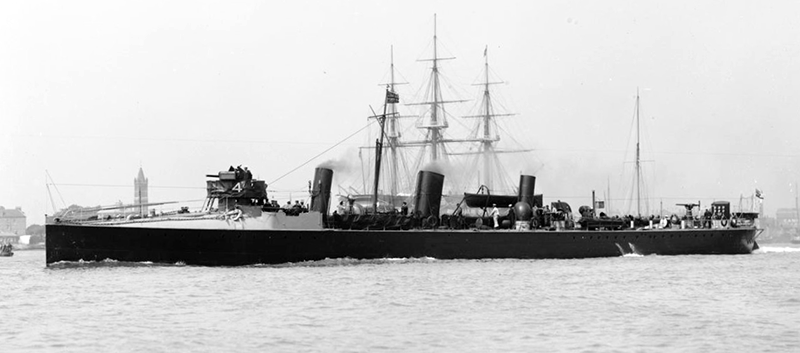
The lineage of British Destroyers started with the “26-knotters” in 1892 by Yarrow, Thornycroft and Laird, and a ramping-up of production to test many navy yards on a follow-up serie was called the “27-knotters”, but they were disappointing, rarely meeting their design speed, suffering from heavy weather and developing many engine troubles leading to reboilering many of these. At least none was completed with loco boilers, all had modern small tubes ones. The naval programme of 1893-94 only specified a top speed and armament. The new 1894-95 programme thus specified 30 knots, knowing theese limitations, now with early experience return.
It’s difficult to really underestimate this effort, with two or three successive ordered given to many yards through 1894-5, 1895-6, 1896-7, 1897-8, 1899 orders and three series of purchases plus three ‘specials’ 33 knotters to Thornycroft, Laird and Thomson ordered in 1896 but completed much later in 1900-1903, leading to the abandonment of VTE for turbines after the success obtained by Thornycroft with the “Turbinia” in 1894. Showcased in the Queen’s Diamond jubilee, at the Spithead Navy Review, 1897, the concept approved an extra order from the RN for military adaptation of his “yacht”, the Velox class.
The “30 Knotters” in brief
There is nothing really revolutionary in general design between the 27 and 30 knotters, as the general outlook was about the same, however given the admiralty wanting a speed increase (achievable in the best conditions anyway) from 27 to 30 knots, four knots, extra output from the horsepower was necessary. So the yards contracted for these orders not only had to reach the speed treshold (verified in sea trials made in the usual fashion -calm sea, half fuel and provisions) concentrated on powerplant design, how to play with different levers. The vertical small tubes, triple expansion model, coupled with double-ended boilers was demonstrated already on the 27 knotters as the winning solution. Now, to get these four additional knots, as some pushed the zeal to plane the next moved to 33-35 kts and already planned boilers upgrades, could be done in many ways:
-Overheating boilers (with the metallurgy limits of time)
-Larger boiler volume for more combustible
-Better efficiency of the expansion (less losses)
-Faster/higher burning rate (with oil injection for example)
-Reach faster shaft revolutions
-Reduce shaft friction and vibrations
-Work on the propeller’s efficiency…
What was achieved in the end was a detail work on all of some of these points by each years, plus the most obvious way, fitting more boilers to the same VTE engine, given the same or superior capacity. The fastest, easiest way for each yard was indeed to just take the former 27-knotter design, stretch it to fit additional boilers.
Design of the 30-knotters
Successful trials of the first destroyers, particularly HMS Daring, showed that higher speeds than the Admiralty had at first thought not possible could be obtained, and in 1894 Thornycroft, Yarrow and Laird were all asked to submit designs for destroyers capable of 30 knots,though at that stage orders could be placed immediately. The first orders went to Thornycroft and other firms produced their own designs and built to them. Yarrow, however, thanks to conflicts with the admiralty over their 27 knotter destroyers, did not receive any orders from the admiralty for several years, and concentrating on building for for foreign navies instead.
As with 27-knotters all firms built their own designs, the only common feature being the complament of 63 and the standard 2pdr and 5-6pdr guns plus two 18-inches TTs. All except Thornycrof models used triple expansion engines, whilst Thornycroft continued with their four cylinder compounds. Hulls were lengthened and the machinery was more powerful than the 27-knotters, but fundamentally the 30-knotters were only enlarged versions of the earlier destroyers.
As with the 27-knotters the high trial speeds were never achieved in service, or even in subsequent trials. Sea speed was more often around the 25kts mark, if that. The light structure of these destroyers caused some trouble with leakage and fractures, though in fact it stood up remarkably well to the strains of wartime service between 1914 and 1918 when these by then elderly vessels were mainly used for coastal patrol work. Many had their funnels raised in an attempt to minimise smoke and cinders at deck level.
Though quite a few of these vessels were delayed in their entrance into the service by difficulties in reaching the contract speed, more delay was caused with the later groups of vessels by the severe labour troubles in the late 1890s in the shipbuilding trades. This class, like most Thornycroft boats, kept their speed well and were particularly manoeuvrable thanks to their ‘semi-tunnel’ sterns, but they tended to be wet forward. They had two funnels.
There were 13 sub-classes, as confirmed by Conways, for the 1894n 1895, 1896 and 1897-98 years. 3 By Thornycroft (xx ships), 2 by Laird (xx ships), 2 by Vickers (xx ships), 2 by Palmers (xx ships), 1 by Doxford (xx ships), 2 by Fairfield (xx ships), 1 by Hawthorn Leslie (xx ships).
Thornycroft 30-knots 1894 – 95 order (DESPERATE) (4, 1897)
Laird 30-knots 1894 – 95 program (QUAIL) (4, 1897)
Vickers 30-knots 1895 – 96 program (AVON) (3, 1897 – 1900)
Laird 30-knots 1895 – 96 order (EARNEST) (6, 1897 – 1898)
Palmers 30-knots 1895 – 96 order (STAR) (6, 1897 – 1898)
Thornycroft 30-knots 1895 – 96 order (ANGLER) (2, 1898)
Doxford 30-knots 1896 – 97 order (VIOLET) (2, 1898 – 1899)
Fairfield 30-knots 1896 – 97 order (GIPSY) (3, 1898)
Palmers 30-knots 1896 – 97 order (FAWN) (2, 1898 – 1899)
Hawthorn Leslie 30-knots 1896 – 97 order (CHEERFUL) (2, 1899 – 1900)
Thornycroft 30-knots 1896 – 97 order (COQUETTE) (3, 1899 – 1900)
Vickers 30-knots 1896 – 97 order (LEOPARD) (1, 1899)
Fairfield 30-knots 1897 – 98 order (LEVEN) (1, 1899)
Hull and general design
The general design of the previous 27-knotters was kept, with some extra lenght for some ships. Dimensions indeed varied between builders and classes. Typical 27-knotters measured 60-64 m (204-216 feets) for 5.75 to 6m (19.5 to 20ft) and 275 to 310 tonnes. The 30 knotters went up to 350-390 tons on average, 65-67m in lenght (215-220 ft) for 6.30-6.40 m in width (20+ ft). As said above, armament was conservative, fixed by the admiralty and similar to the 27-knotters (see below). These ships had a crew nominally of 53 but it varied up to 60.
Powerplant
This of course changed considerably between yards. Boilers types and triple expansion steam engines varied between classes, for an average output up to 6,300 shp (most ships) and down to 5,700 ihp (Thornycroft early boats). The latter stuck to their compound machinery. 33 knots (37 mph, 61 kph) was purely administrative and theoretical, as said above, the best service speed wad 25 knots in moderate seas. These diverged considerably in nature, with Normand, Thonycroft models, and allegedly the most reliable, beng the Reed models of the Palmers Yard boats. Unlike the 27 knotters, they were through far less reboilering changes. It seems reliability in general was increased across the board and all the boast that were not lost due to collision or other causes, served in WWI (see later). They all had two shafts with three-bladed propellers, four boilers truncated in various ways and two VTE steam engines. The Thornycroft boats had their two boiler groups truncated in pairs, making for a two-funnel profile and thus, were reclassified as the “B” class later. The majority went with the 3 funnel solution, with the central boiler group truncated into one larger funnel, and fore and aft ones single. That’s why when reclassified as the “C” class, most 30-knotters were assimilated. And there were the exceptions: The Laird Boats, which were four funneled and thus, reclassified as “D” class in 1913 and thus, assimilated to the 33 knotters. But as said above these speed classifications made little sense prior to WWI.
Armament
Main: QF 12-pounder 12 cwt naval gun
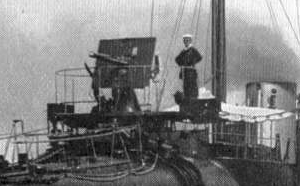 The QF 12-pounder 12 cwt naval gun was brand new when the 26-knotters were in construction, enterering service in 1894. placed on a raised platform overlooking the foredeck, and generally behind a platform protected by canvas. This 0.6 tons (510 kg) ordnance made a superb career going up to 1945, with more than 8,000 delivered. It was also used by Italy and Japan and became the staple of light artillery on most RN ships, especially those of WW1. In the case of these destroyers, the Mark I was shielded and placed on the conning tower platform, high enough to avoid water spray. But in heavy weather, as the ship were ploughing deep due to their turtleback, they were wet anyway.
The QF 12-pounder 12 cwt naval gun was brand new when the 26-knotters were in construction, enterering service in 1894. placed on a raised platform overlooking the foredeck, and generally behind a platform protected by canvas. This 0.6 tons (510 kg) ordnance made a superb career going up to 1945, with more than 8,000 delivered. It was also used by Italy and Japan and became the staple of light artillery on most RN ships, especially those of WW1. In the case of these destroyers, the Mark I was shielded and placed on the conning tower platform, high enough to avoid water spray. But in heavy weather, as the ship were ploughing deep due to their turtleback, they were wet anyway.
Specs:
It used a Separate-loading QF round, caliber 7.62 cm, with a single-motion screw breech.
Rate of fire was 15 rounds per minute, at 2,210 ft/s (670 m/s) for an effective range of 11,750 yd (10,740 m) at 40° for the latter version.
Secondary: 3-5 QF 6-pdr Hotchkiss
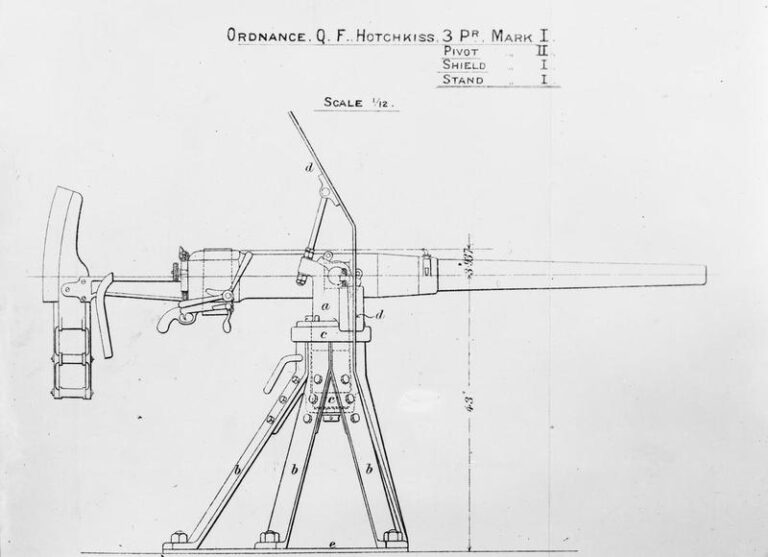
This “classic among classic” was developed in 1883 by Hotchkiss et Cie and a licenced was acquired by Elswick in Britain for mass manufacturing. It became the go-to light QF gun, still very much in favor by the 1890s. Weighting around 821–849 lb (372–385 kg) and shielded, the three guns were located forward for the first pair, abreast the main 12-pdr behind bulwark (but they were wet also) and the third was located on an axial platform aft, close to the stern.
Later in the early 1900s the side TTs were removed and replaced by two more, also shielded, placed on sponsoned platforms for a better arc of fire forward and aft.
Together with the 3-in gun (12 pdr) they could send 140 rounds every minute at the infortunate TB that could cross their path. They generally replaced the dismoured bow tube (not installed on the bulk of the 27 knotters).
Specs:
57x307R 57-millimetre (2.244 in), Vertical sliding-block breech, 4 inch hydro-spring recoil
Rate of fire 25/minute at 1,818 feet per second (554 m/s), range 4,000 yards (3,700 m)
Torpedo Tubes
The Type used was likely the 18-inches Whitehead (45 cm) type, developed in 1888, and introduced as the 26-27 knotters were completed in 1894:
They weighted 845 lbs. (383 kg) for 140 in (3.556 m) in lenght, with an explosive charge of 118 lbs. (53.5 kg) using wet gun-cotton, single setting, 800 yards (730 m) at 26.5 knots (which was actually slower than the destroyer’s top speed!). It was driven by a three cylinder radial Brotherhood pattern engine, fed by an Air-flask (cold running) of compressed air.
No upgrade as they were ultimately all retired. Outside the bow tube, the two other ones were axial, located aft, often before the aftermost funnel and close to the aft steering post and before the stern gun. Six torpedoes were carried, the three already in the tubes, and three spares.
Specifications Star class, Palmers |
|
| Displacement | 360 long tons, 366 short tons, 440t FL |
| Dimensions | 67.1 oa 65.5 pp x 6.37 x 2.97m (219 x 21 x 9.7 ft) |
| Propulsion | 2 shafts 4-cyl VTE, 4x Reed boilers 6,200 hp (5,000 kW) |
| Speed | 30 knots (56 km/h; 35 mph) |
| Range | 3,000 nmi () at 10 knots, 95t coal |
| Armament | Standard 1×12-pdr/40 12cwt QF Mk I, 5x 6-pdr Hotchkiss Mk I, 2x 18-in TTs (4 torpedoes) |
| Crew | 63 |
Appearance

USS Mallard. Note the white hull. Other vessels of the same Thonycroft 1894 group had a black funnel.
All these ships differed in profiles just as the 27-knotters did. Some had two, three or four funnels (the usual case), but at least they all had in common the usual turtleback prow, followed immediately by a small conning tower offering a bit more protection (although blinded by water spray) than the open bridge aft of the main gun. The stern was rounded with the ‘semi-tunnel’ feature improving stability, and the rudder was very large. However the same issue was noted: Their top speed, already degraded in service condition, fell to a few knots and they were very wet. Past some heavy sea state, they were only able to a crawl unable to perform any significant interception mission. Cruisers were much faster by all accounts.
All these problems would not be cured on the next 33-knotters serie, nor even the turbine “specials”, but the River class, first fitted with a forecastle. Britain led the pack on this.
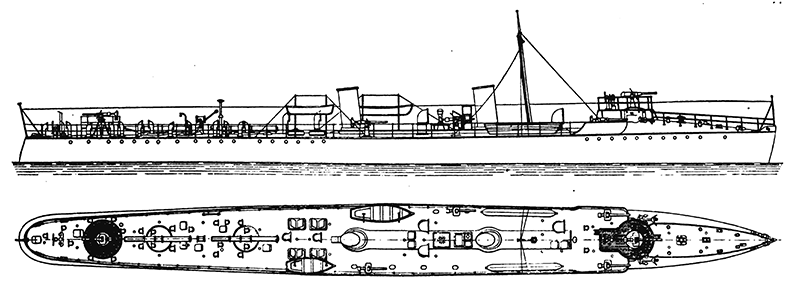
Profile 2 views of HMS Fame, Thornycroft 1894 class.
Active service
Combat records in WWI
Despite the critcism, they still proved their worth in WW1, as lead ship for torpedo boat groups, equally old and worn out. They performed countless ASW patrols, where the speed was not always an issue for the task. Several were lost by various causes. One by gunfire (HMS Flirt) on 27.10.1916 after an encounter with German destroyers by night as part of the always dangerous Dover patrol. Others were sunk by U-Boats, HMS Recruit on 1.5.1915 by UB16 (North Sea), and there was the odd case of Fairy which on 31.5.1918 in the North Sea, rammed, sank UC75, but the damage was such she sank in turn. The remainder were lost by mines: HMS Coquette and Cheerful.
Early years were in divisions placed in several strategic areas around the british islands, from Scotland to the tip of Cornwall. The lagest ones were off the Channel. In 1905 as the Russian Baltic fleet was sailing though it in the fog, British trawlers were fired at by very nervous commanders based on a rumor that due to the recent anglo-Japanese alliance, there were IJN destroyers or teorpedo boats waiting for them. This nearly led to war, but the incident was eventually buried. In 1913 they were all reclasses a bit artificially (see below) and grouped in various channels ports and around the british Isles to perform ASW patrols.
Usually wet and uncomfortable with cramped crew quarters, they proved still their toughness during war service, despite being twenty years old. Their watertight bulkheads, thin plating and light structure still enabled them to take a great deal of damage and remain afloat. In heavy weather however, their plates buckled easily resulting in drag and poor handling generally. When available in 1915-16 they all received two depht charge racks placed at the stern. It should be noted that destroying submarines by gunfire was the only tactic until depth charges were developed. Even more than the 27 knotters, they had successes against U-Boats.
HMS Wolf (Laird boat, 1895 order) was a good example of these wartime modifications: She was part of the Seventh Flotilla in June 1917 when her refit took place, until September 1917. She was afterwards transferred to the Northern Division of the Coast of Ireland Station (HQ Buncrana, Donegal). She patrolled in the North Channel between Scotland and the north of Ireland. Her second refit was more radical, as by April 1918, her torpedo tubes were landed as her aft gun to accommodate 18 depth charges plus two depth charge throwers.
HMS Panther (1897)
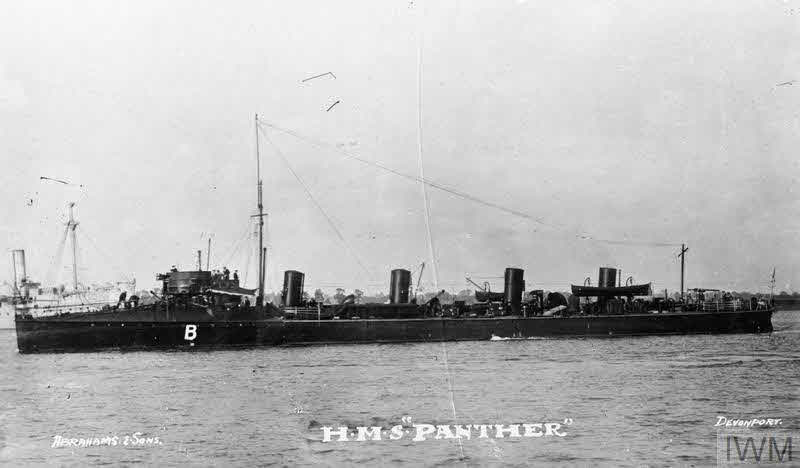
HMS Panther was a Laird boat, which effectively reached 30.14 knots (55.82 km/h; 34.68 mph) during sea trials, her fitting out completed in January 1898. By July–August 1900 she took part in the Annual Manoeuvres. On 20 April 1901 she changed commander for Lieutenant and Commander A. K. Macrorie and replaced HMS Osprey in Devonport instructional flotilla. By July–August 1901, she was again in annual manoeuvres and by early December 1901 changed commander for Cecil Lambert, becoming a tender to the battleship HMS Illustrious, Mediterranean station until recalled back home and change commander again.
She left Devonport for Malta in January 1902 under Lieutenant Cdr. Lancelot Napier Turton, stopping at Lemnos by August 1902 and on 27 October 1904, collided with HMS Bat. Both were repaired in Malta and Panther was recalled to British waters in 1906. By August she replaced Orwell in the 2nd Destroyer Flotilla and by August 1907, she was transferred to the 4th Destroyer Flotilla, with reported defects rectified at Sheerness. By December 1908, she joined the Eastern Group in Harwich. She had a refit at Sheerness until March 1909, and back to Harwich, in what became the 1st Destroyer Flotilla
She was replaced there by the Tribal-class destroyer HMS Sarace in June, and so she was the last “30-Knotter” in service with the 1st Flotilla. By August 1910 she was in the Nore flotilla, and refitted at Chatham Dockyard? By October 1911 she was assigned to the 5th Destroyer Flotilla in Devonport (nucleus crews), docked for propeller damage repairs (collision with the Pier). 30 August 1912 saw her relocated to the B class and she was found in a newly created Patrol Flotilla, her’s being the 7th at Devonport from March 1913.
Before the war erupted by July 1914 she was sent to Dublin Bay to guard against Irish nationalists arms smuggling run. It was expected Waterford (south) and Panther sailed there, for an operation at Howth, which succeeded. She returned to the 7th Flotilla which was redeployed to the Humber River (East coast). Their role was to intercept any German incursion of vessels intended of minelaying or torpedo attacks in these approaches. This was her post until August 1917, and by September she was relocated at the Nore, still listed by March 1918 but reassigned to the 6th Destroyer Flotilla, (Dover Patrol) until November 1918, and refitted on V-Day. She was sold for scrap on 7 June 1920.
1913 Reclassification
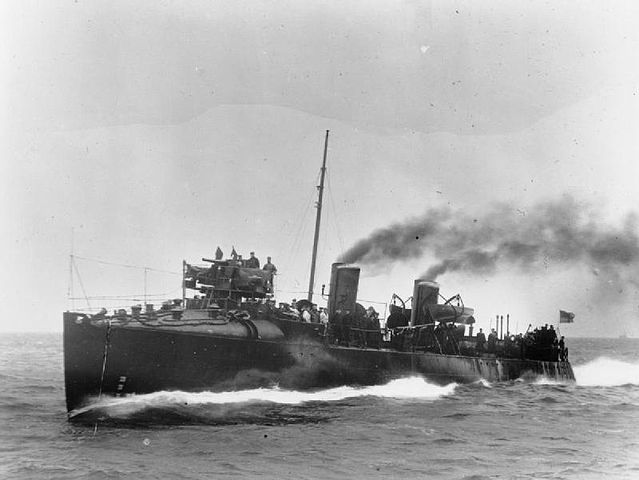
HMS Fame in sea trials, 1896.
In 1913 all “30 knotter” vessels with 3 funnels were reclassified by the Admiralty as the “C” class, providing some organization for all these “pre-river” destroyers. This made things complicated as not all 33 knotters ended in this “C” class, as 4-funnelled, “30 knotters” went with the earlier “B” class, which were the 27 Knotters, and the 2-funnelled ones went with the “D” class, or 33-knotters. It was a deliberate will, quite artificial, to get rid of a speed classification which had at that stage no meaning as all remaining ships were worn out by that stage already. They were not liked by their crews, with a distinctive turtleback intended to clear water but tended to dig the bow into waves instead, making the while ship very wet, especially the conning position (its vision slits were pepetually blinded by spray). They were generally seen as and poor seaboats unable to reach their designated top speed. This reclassification ws accompanied by two pennant number changes as well.
Classification chart B-class destroyers
Laird Quail class : Quail, Sparrowhawk, Thrasher, Virago
Laird Earnest class: Earnest, Griffon, Locust, Panther, Seal, Wolf, Express (steam-turbine “special” 1896–97 programme), Orwell
Laird Lively class: Lively, Sprightly, Success
Palmers (4-funnelled): Jarrow, Spiteful, Peterel, Myrmidon, Syren, Kangaroo
J & G Thomson: HMS Arab (high-speed “special” 1896–97)
Armstrong Whitworth: HMS Cobra (steam-turbine powered “special”)
Palmers final group (steam turbine): Albacore, Bonetta (1906-07)
Classification chart C-class destroyers
Palmer 30 knotters: Bat, Chamois, Crane, Fawn, Flirt, Flying, Fish Star, Whiting
Earl 30 knotters: Bullfinch, Dove
Doxford: 30 knotters: Lee, Sylvia, Violet
Vickers 30 knotters: Avon, Bittern, Leopard, Otter, Vixen
Clydebank 30 knotters: Brazen, Electra, Recruit, Vulture, Kestrel, Thorn, Tiger, Vigilant
Hawthorn Leslie 30 knotters: Cheerful, Mermaid, Greyhound, Racehorse, Roebuck
Fairfields 30 knotters: Fairy, Falcon, Gipsy, Leven, Osprey, Ostrich
Thornycroft 33 knotters: HMS Albatross
Parsons turbine specials: HMS Velox, Viper
Classification chart D-class destroyers
First group (1894–1895 programme): Desperate, Fame, Foam, Mallard
Second group (1895–1896 programme): Angler, Ariel
Third group (1896–1897 programme): Coquette, Cygnet, Cynthia
Last group (1897–1898 programme): HMS Stag
Sources
Books
Chesneau, Roger & Kolesnik, Eugene M., eds. (1979). Conway’s All The World’s Fighting Ships 1860–1905. London: Conway Maritime Press.
Colledge, J. J.; Warlow, Ben (2006). Ships of the Royal Navy: Complete Record of all Fighting Ships of the Royal Navy. Chatham Publishing.
Dittmar, F.J.; Colledge, J.J. (1972). British Warships 1914–1919. Shepperton, UK: Ian Allan.
Friedman, Norman (2009). British Destroyers: From Earliest Days to the Second World War. Barnsley, UK: Seaforth Publishing.
Gardiner, Robert & Gray, Randal, eds. (1985). Conway’s All The World’s Fighting Ships 1906–1921. London: Conway Maritime Press
Lyon, David (2001) [1996]. The First Destroyers. London: Caxton Editions.
Manning, T. D. (1961). The British Destroyer. London: Putnam & Co.
March, Edgar J. (1966). British Destroyers: A History of Development, 1892–1953. London: Seeley Service.
Links
C class on dreadnoughtproject.org/
D class on dreadnoughtproject.org/
C on historyofwar.org/
D on historyofwar.org/
The C class on wikipedia
The D class on wikipedia
Thornycroft 1894 on navypedia
Generic RN destroyers on navypedia
All sub-classes by builder
 Thornycroft orders
Thornycroft orders
1894 Desperate class: Desperate, Fame, Foam, Mallard
First Thornycroft boats ordered by the admiralty based on the new 30 kts specs. Two funnels, so they were later reclassified as “B class”, as the 27-knotters…
Built at Thornycroft, HMS Chiswick, the very first, HMS desperate was laid down on 1.7.1895, launched 15.2.1896 and commissioned in 2.1897 (sold 5.1920)
HMS Fame was launched on 15.4.1896, sold 8.1921. HMS Foam on 8.10.1896 but sold in May 1914, not seeing WWI. HMS Mallard was launched on 19.11.1896, sold in February 1920.
Quick specs:
Displacement 310/350t, 64.0 oa 63.4 x 5.97 x 2.13m, 2x 4-cyl VTE, 3 Thornycroft boilers 5,700 shp, coal 80t, range 3000 nm/10 kts
Thornycroft 1896-97 order: COQUETTE class: Coquette, Cynthia, Cygnet
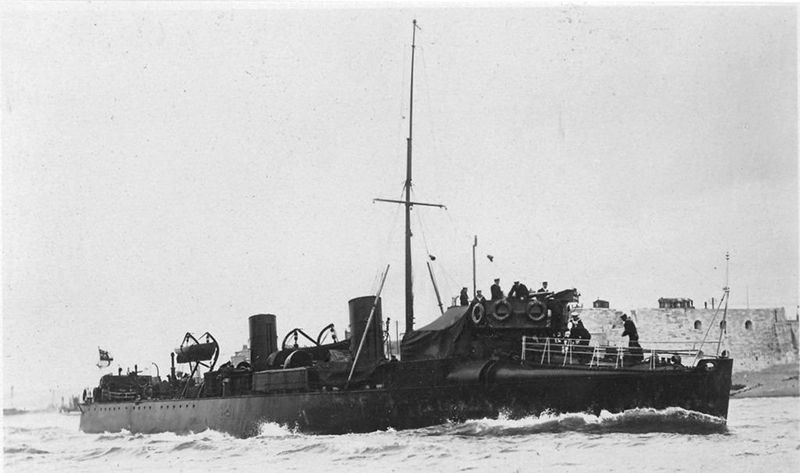
Three Thornycroft Chiswick boats, as usual two funneled (and so reclassified as “B” class 1913), launched 1897-98, completed 1899-1900. All sold postwar but HMS Coquette which hit a mine 7.3.1916 off the East Coast.
Quick specs:
Displacement 335/367t, 64 x 5.97 x 2.26m, 2 shafts 4-cyl VTE, 3 Thornycroft boilers, 5700 shp, 95t coal.
Thornycroft 1895 order: Angler class: Angler, Ariel
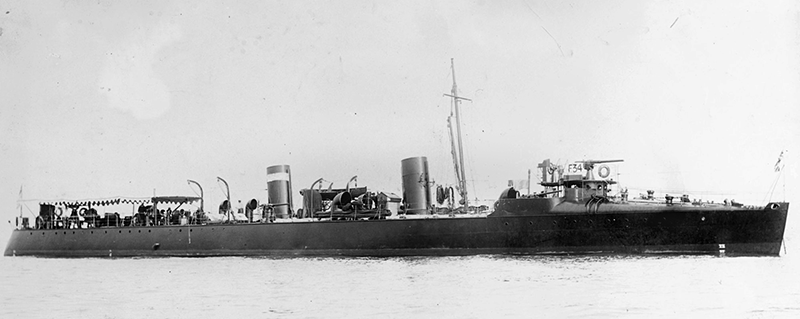
Two 2-funneled destroyers from Thornycroft, Chiswick. Tall mast. Reclassed as “B” class 1913. Ariel was wrecked on 19.4.1907 as she grounded on rocks off a breakwater at Malta (pitch-dark and gale). Total constructive loss, leaving her sister ngler alone in WWI. The latter was sold in 1920.
Quick specs:
Displacement 310/352t, 64 x 5.97 x 2.13m, 2 shafts 4-cyl VTE, 3 Thornycroft boilers, 5700 shp, 85t coal.
Also HMS Stag 1897-98 order (launched 18.11.1899), actove WWI, sold 3.1921
Thornycroft 33 knots special:
HMS Albatross, laid down 27.11.1896, launched 19.7.1898, comp. 7/1900, active WWI and sold 6.1920
Specs: Displacement 430/490t, 69.2 x 6.49 x 2.77, 2 shafts 4-cyl VTE, 4 Thornycroft boilers 7500 shp (speed 31.5 kts), coal 105t, crew 69
 Laird orders:
Laird orders:
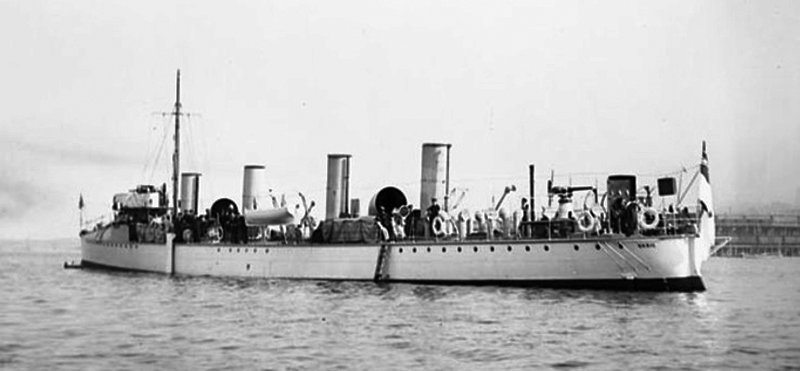
Quail class: Quail, Sparrowhawk, Thrasher, Virago
Four funneled ships, first order by Laird, Birkenhead. First three were laid down the same days on 28-30.5.1895. Completed in June 1897. Three in service in WWI, reclassified in the “D” class, four-funnels ships. The first was sold on 7.1919 and two others on 11.1919 and 10.1919 respectively, but HMS Sparrowhawk was wrecked 17.6.1904 and judged total constructive loss. At that stage they were heavily criticized in the RN, and no occasion was spared to get rid of them, avoiding repairs.

Quick specs:
Displacement: 355/415t for 66.5 x 6.58 x 2.90m, 2x 4-cyl VTE, 4 Normand boilers, 6,300 shp, 95t coal, 3000 nm/10 kts.
Laird 1895-96: Earnest Class: Earnest, Griffon, Locust, Panther, Seal, Wolf (ex-Squirrel)
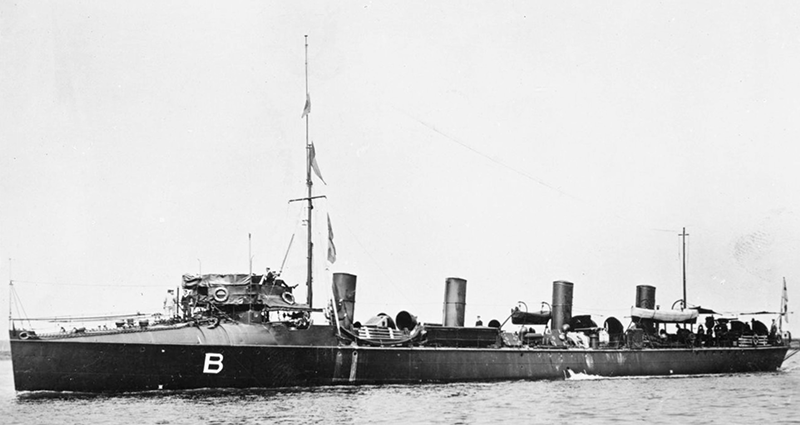
Four funnel ships reclassified as “C” class 1913. Received in WWI two DCR (Depth charge racks). Very strongly built but poor agility. They were laid down in early 1896, launched late same year, completed 1897-1899. Earnest was sold 7.1920 as Griffon, Panther but Locust on 6.1919, Seal, Wolf (ex-Squirrel) on 1921. So they all took part in WW1 operations.
Quick specs:
Displacement 355/415t, 66.5 x 6.55 x 3.02, 2 shafts 4-cyl VTE, 4 Normand boilers, 6300 shp, coal 95t, 3000 nm/10 kts
-Also HMS Orwell (launched 29.9.1898), 1897-98 orders, sold 7.1920
-Also Lively class: Lively, Sprightly (purchased 1901) launched 25.9.1900, comp. 3.1902. Active WWI, sold 1920-21.

Laird 33 knots special: (1896-97 order), HMS EXPRESS launched 11.12.1897, comp. 2/1902, active WWI, sold 3.1921
 Vickers orders
Vickers orders
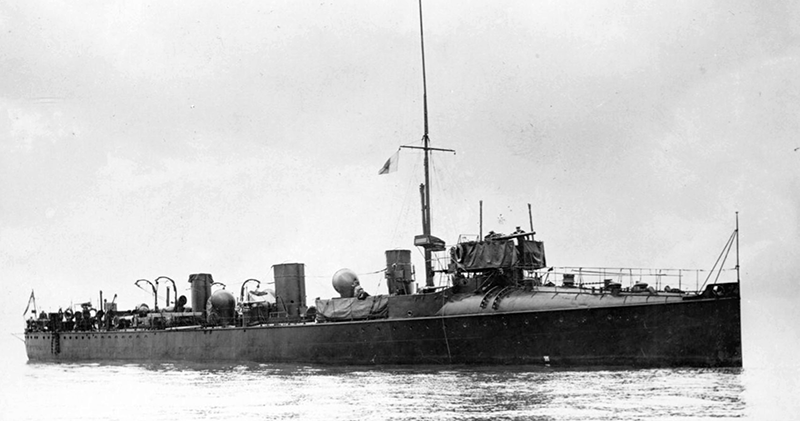
Avon class: Avon, Bittern, Otter
HMS Avon like the other three were made at Vickers, Barrow based on the 1895-96 orders. The cimpany was known at the time Naval Construction & Armaments Co. Launched 1896, comp. 1899, as 3-funnels ships (C class). Avon was sold on 7.1920 but Bittern was lost during a collision on 4.4.1918 and Otter was sold 10.1916 already.
Quick specs:
Displacement 355/405t, 65.3 x 6.10x 2.52m, 2 shafts 4-cyl VTE, 4 Thornycroft boilers, 6,300 nm, 86t oil, 3,000 nm/10 kts
-Also HMS Leopard (D75, D61, D50, H06) launched on 1896-97 orders, 20.3.1897. Active WW1, sold 6.1919
-Also HMS Vixen (1899 order) launched 29.3.1900, comp. 3/1902 active WWI, sold 3.1921
 Palmers 1895-96: Star class
Palmers 1895-96: Star class
Star, Whiting, Bat, Crane, Chamois, Flying, Fish
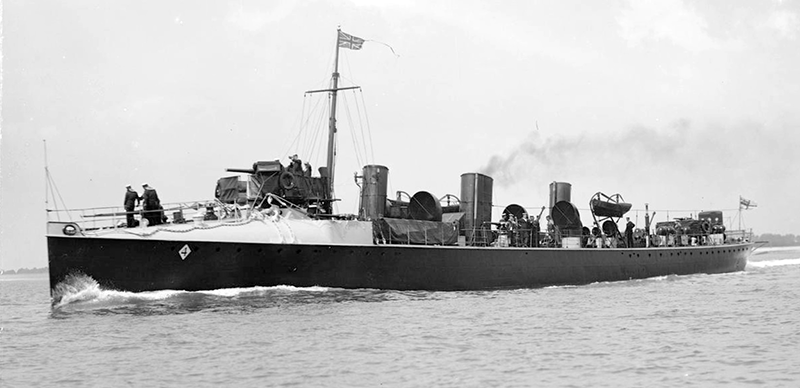
Palmers 1895-96: Star class: Star, Whiting, Bat, Crane, Chamois, Flying, Fish
Three funneled destroyers (the admiship one was truncated). The first pair were ordered on 23.12.1895, the rest in 9.1.1896. The admiraklty reported they were best all-round 30-knotters. Their machinery was indeed extremely reliable, albait not reaching always the required speed. All but one took part in WWI operations: HMS Chamois indeed on 26.9.1904 saw one her propeller blades lost while doing a speed run in the Gulf of Patras (Greece). The blades still spinning managed to cut a huge gash along the hull, enough to circumvent the bulkheads and sink her. Fortunately the crew was close to shore.
Quick specs:
Displacement 390/440t; 67.1 x 6.37 x 2.97, 2 shafts 4-cyl VTE, 4 Reed boilers 6200 shp, coal 95t, same range.
Palmers 1896-97 order: Fawn class: Fawn, Flirt
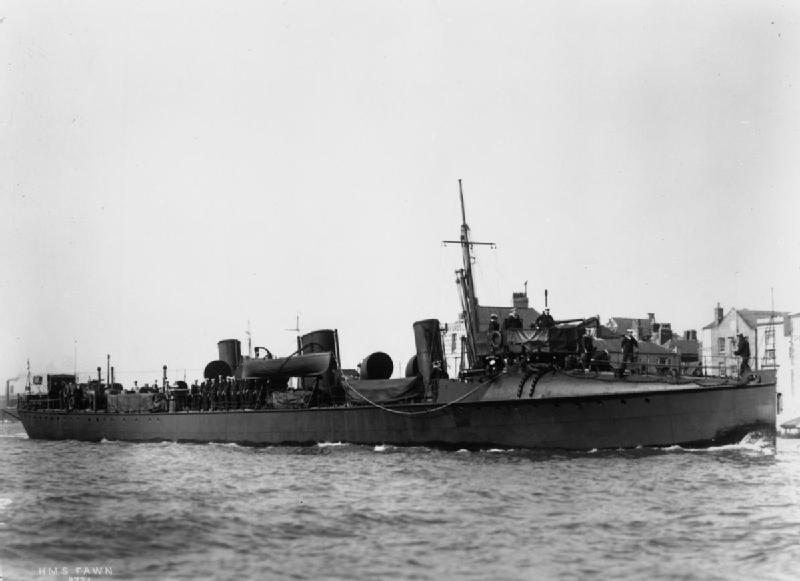
Both made at Palmers, Jarrow laid down 5.9.1896, launched 13.4.1897 and 15.5.1897, comp. 12.1898 or 4.1899. 3-funneled, short mast (C class 1913). The first one served in WWI and was sold in 1919, her sister was sunk on 27.10.1916 after an encounter with German destroyers in a night raid, Dover Straits.
Quick specs:
Displacement 440t FL, 67.1 x 6.37 x 2.97m, 2 shafts 4-cyl VTE, 4 Reed boilers, 6200 shp, 95t coal.
Also Spiteful, Peterel (1896-97 orders), launched 1899, active WWI, sold 1919-1920
Also Myrmidon, Syren (1899 order) launched 20.12.1900, comp. 1902. First lost collision 26.3.1917, second active WWI, discarded postwar. Diverged in displacement.
Also HMS Kangaroo launched 8.9.1900 (purchased 1900), comp. 7/1901, active WWI, sold 3.1920
 Doxford 1895 orders
Doxford 1895 orders
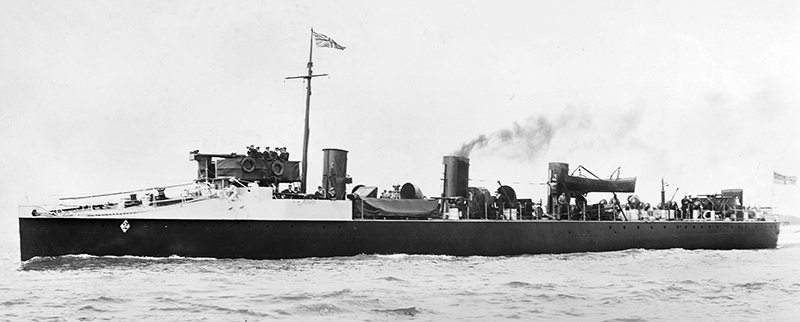
1895 orders: Violet class: Violet, Sylvia
Two Doxford, Pallion built 30 knotters, three funnels, short mainmast. Reclassified as “C” class in 1913. Both fought in WW1. In 1917 or 1918 they receiced depht charge racks. Sold 1919-1920.
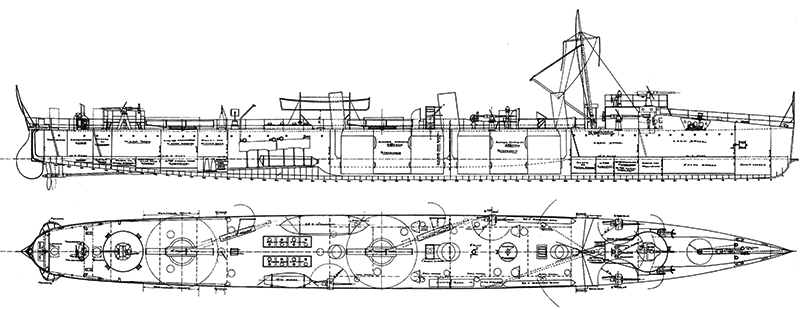
Quick specs
Displacement 350/400t, 65.2 x 6.40 x 2.92m, 2 shafts 4-cyl VTE, 4 Thornycroft boilers 6300 shp, 90t coal.
–HMS Lee (1897-98 order) launched 27.1.1899, comp. 3.1901, wrecked 5.10.1909.
–HMS Success (1899 order) launched 21.3.1901. Wrecked 27.12.1914
 Fairfield Orders
Fairfield Orders

1896-97 order: GIPSY class: HMS Gipsy, Osprey, Fairy.
Three Fairfield, Govan next order (1896) three-funneled, short masted destroyers. Reclassed as “C” class 1913. Gipsy (P23, D58, D43) was launched 1.10.1896, Osprey on 7.4.1897 and Fairy on 29.5.1897. She was the only one not to see action in WWI as she foundered 31.5.1918, while the North Sea, ramming and sinking UC75, and as a result she was so badly damaged that she sank soon after, leaving little time to her crew to evacuate. Gipsy’s was disposed of in 1921 but becoming later a floating pontoon at Dartmouth for many years.
Quick Specs:
Displacement 355/400t, 65.7x 6.48x 2.49m, 2 shafts 4-cyl VTE, 4 Thornycroft boilers, 6300 shp, coal 85t
Also 1897-98 order HMS Leven (P33, D62, D51) laid down 24.1.1898, launched 28.6.1898, sold 9.1920.
Also Falcon, Ostrich (1899 order) launched late 1899, comp. 1901. First lost in collision 1.4.1918, second active WWI, sold 4.1920
 Hawthorn Leslie orders
Hawthorn Leslie orders
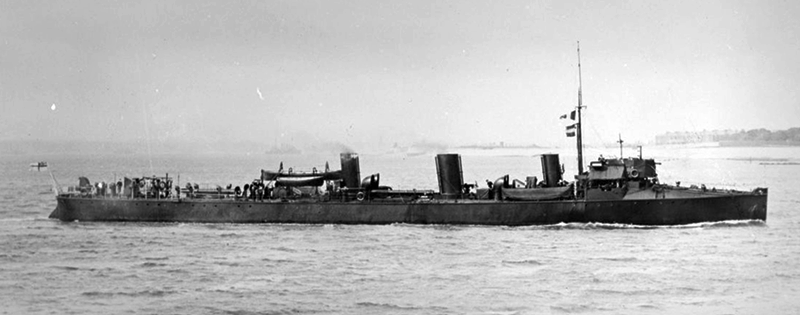
1896-97 order: CHEERFUL class: cheeful, mermaid
3 funnels destroyers from Hawthorn Leslie, Hebburn, 3 funnels (later C class), short mast. Cheerful (P13, D49) and Mermaid were launched on 14.7.1897 and 22.2.1898, comp. 6.1899 and 2.1900. Mermaid was sold 7.1919 but her sister did not survived WWI: She hit a mine off the Shetlands on 30.6.1917.
Quick specs:
Displacement 355/400t, 65.5 x 6.40 x 2.49m, 2 shafts 4-cyl VTE, 4 Thornycroft boilers 6100 shp, 92t coal.
-Also Greyhound class: Greyhound, Racehorse, Roebuck (1899 order) launched 1900-1901, comp. 1902, all active WWI, sold 1919-1920
 Thomson Orders
Thomson Orders

1895-96 order: Brazen class: Brazen, Electra, Recruit, Vulture
3 funnels, central one truncated. Short mast. Active in WWI, sold postwar. HMS Recruit was torpedoed on 1.5.1915 by UB16 in the North Sea, close to the Galloper light vessel.
Quick specs:
Displacement 380/425t, 65.2/66.5/67.8m x 6.09 x 2.52, 2 shafts 4-cyl VTE, 4 Normand boilers, 5800 shp, 80t coal.
-Also, single ship order 96-97, HMS Kestrel (launched 25.3.1898), sold 3.1921.
-Also Thorn, Tiger, Vigilant launched 1900 under new new company name “John Brown”. Purchased 1900. Tiger lost by collision 2.4.1908.
 Earl Orders
Earl Orders
1896-97 order: Bullfinch class: Dove, Bullfinch.
3 funnels, short mast, launched 1898, comp. 1901, C-class 1913, active WWI and sold 1919-1920
Quick specs:
Displacement 345/390t 65.4 x 6.27 x 2.39m, 2 shafts 4-cyl VTE, 4 Thornycroft boilers, 5800 shp, 86t coal.

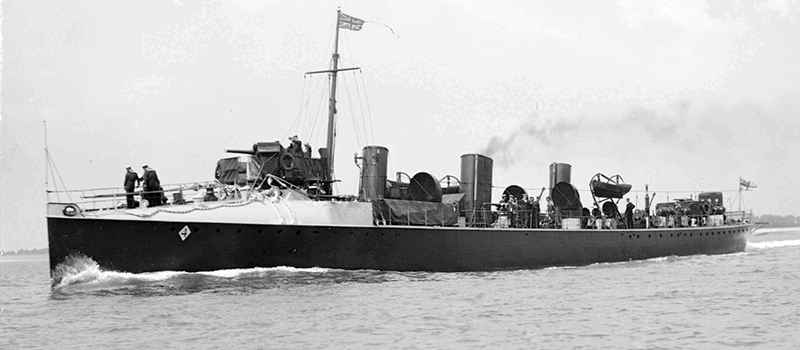

 Latest Facebook Entry -
Latest Facebook Entry -  X(Tweeter) Naval Encyclopedia's deck archive
X(Tweeter) Naval Encyclopedia's deck archive Instagram (@navalencyc)
Instagram (@navalencyc)





 Austrian Navy
Austrian Navy French Navy
French Navy Royal Navy
Royal Navy Armada Espanola
Armada Espanola K.u.K. Kriegsmarine
K.u.K. Kriegsmarine Dansk Marine
Dansk Marine Nautiko Hellenon
Nautiko Hellenon Koninklije Marine 1870
Koninklije Marine 1870 Marinha do Brasil
Marinha do Brasil Osmanlı Donanması
Osmanlı Donanması Marina Do Peru
Marina Do Peru Marinha do Portugal
Marinha do Portugal Regia Marina 1870
Regia Marina 1870 Nihhon Kaigun 1870
Nihhon Kaigun 1870 Preußische Marine 1870
Preußische Marine 1870 Russkiy Flot 1870
Russkiy Flot 1870 Svenska marinen
Svenska marinen Søværnet
Søværnet Union Navy
Union Navy Confederate Navy
Confederate Navy Armada de Argentina
Armada de Argentina Imperial Chinese Navy
Imperial Chinese Navy Marinha do Portugal
Marinha do Portugal Mexico
Mexico Kaiserliche Marine
Kaiserliche Marine 1898 US Navy
1898 US Navy Russkiy Flot
Russkiy Flot French Naval Aviation
French Naval Aviation Russian Naval Aviation
Russian Naval Aviation Sovietskiy Flot
Sovietskiy Flot Royal Canadian Navy
Royal Canadian Navy Royal Australian Navy
Royal Australian Navy RNZN Fleet
RNZN Fleet Chinese Navy 1937
Chinese Navy 1937 Kriegsmarine
Kriegsmarine Chilean Navy
Chilean Navy Danish Navy
Danish Navy Finnish Navy
Finnish Navy Hellenic Navy
Hellenic Navy Polish Navy
Polish Navy Romanian Navy
Romanian Navy Turkish Navy
Turkish Navy Royal Yugoslav Navy
Royal Yugoslav Navy Royal Thai Navy
Royal Thai Navy Minor Navies
Minor Navies Albania
Albania Austria
Austria Belgium
Belgium Columbia
Columbia Costa Rica
Costa Rica Cuba
Cuba Czechoslovakia
Czechoslovakia Dominican Republic
Dominican Republic Haiti
Haiti Hungary
Hungary Honduras
Honduras Estonia
Estonia Iceland
Iceland Eire
Eire Equador
Equador Iran
Iran Iraq
Iraq Latvia
Latvia Liberia
Liberia Lithuania
Lithuania Mandchukuo
Mandchukuo Morocco
Morocco Nicaragua
Nicaragua Persia
Persia San Salvador
San Salvador Sarawak
Sarawak Uruguay
Uruguay Venezuela
Venezuela Zanzibar
Zanzibar Warsaw Pact Navies
Warsaw Pact Navies Bulgaria
Bulgaria Hungary
Hungary

 Bundesmarine
Bundesmarine Dutch Navy
Dutch Navy Hellenic Navy
Hellenic Navy Marina Militare
Marina Militare Taiwanese Navy
Taiwanese Navy Chinese Navy
Chinese Navy Indian Navy
Indian Navy Indonesian Navy
Indonesian Navy JMSDF
JMSDF North Korean Navy
North Korean Navy Philippines Navy
Philippines Navy ROKN
ROKN IDF Navy
IDF Navy Royal New Zealand Navy
Royal New Zealand Navy Egyptian Navy
Egyptian Navy South African Navy
South African Navy

































 RN
RN
 Marine Nationale
Marine Nationale
 Soviet Navy
Soviet Navy
 dbodesign
dbodesign